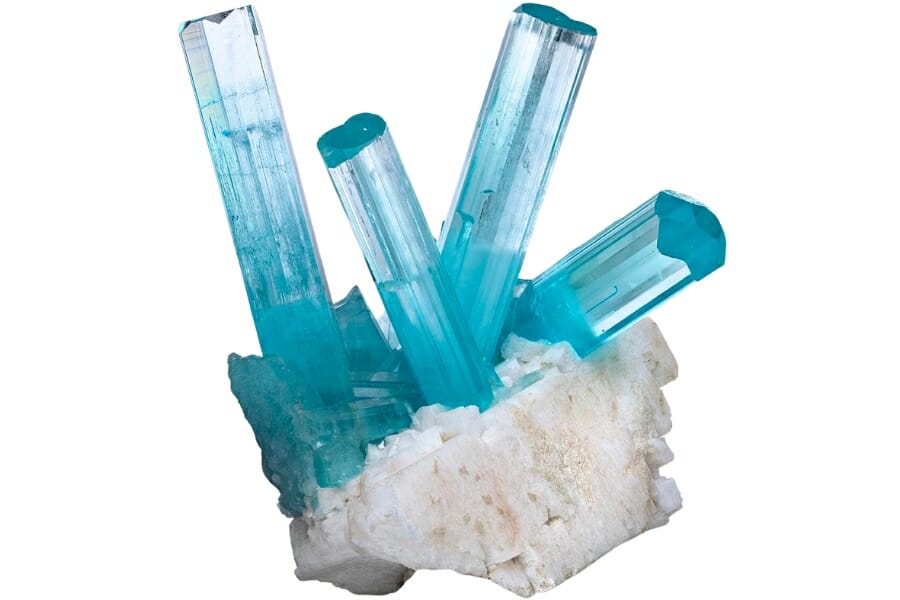Aquamarine, a sparkling blue gemstone, is a favorite for many gem enthusiasts, and it’s easy to see why. With its calm, ocean-like hues, it’s often associated with tranquility and the soothing power of the sea.
Just as the ocean holds many wonders, so too does this gem. The tricky thing is that there are a lot of gemstones that can easily be mistaken for it. With so many other blue gems, you might be wondering how to tell if your aquamarine is real.
But don’t worry, we’ve got you covered! We’ll delve into the unique features of a genuine aquamarine. By getting to know its specific characteristics, you’ll be able to successfully understand how to identify real aquamarine from a mile away.
Overview Of Natural Aquamarine And Why Fakes Are Common

Aquamarine is a breathtaking gemstone that’s part of the beryl family of minerals, the same family that the famous green emerald belongs to. It’s formed when molten rock or magma cools and solidifies. The specific conditions of the surrounding environment, like the presence of iron, give aquamarine its unique blue color.
The unique thing about aquamarine is its range of blue colors. It can be a pale, almost transparent blue or a deeper, vibrant blue. Unlike some gems that might change color based on the lighting, aquamarine usually stays consistent in its hue.
Because of its beauty and durability, this gemstone is a popular choice for jewelry. Beyond this, aquamarine has been used historically by sailors who believed it could keep them safe on the water.
Like other gemstones, the value of aquamarine depends on different factors, but those that have a rich blue color and high clarity are generally more valuable. If you own or are thinking of buying aquamarine, you’re truly getting a piece of nature’s art!
Why you’re seeing more fake aquamarine these days
Aquamarine’s popularity has soared because of its beautiful blue color and its elegance. This high demand makes it a target for people who create fake gemstones to trick buyers and make quick money.
One reason we’re seeing more fake aquamarines is that creating convincing imitations has become easier thanks to advancements in technology. There are now methods to make glass look a lot like real aquamarine. These fakes can be sold at the price of genuine aquamarine, fooling many buyers.
Sometimes, other less expensive blue gemstones are also misrepresented and sold as aquamarine. These stones might look similar to the untrained eye, but they are not the real deal.
This problem is further exacerbated by online shopping. When buying online, it’s harder for people to inspect the gem closely to confirm its authenticity before making a purchase.
Besides, there’s a lack of knowledge among many buyers regarding how to identify aquamarine. This makes things easier for dishonest sellers. They prey on the unawareness of the general public, making it crucial for you to educate yourself on how to tell if an aquamarine is real.
How To Identify Real Aquamarine
There are lots of proven tips to identify rocks in general, but if you want a focused discussion on how to identify real aquamarine, below are some of the most helpful ways you can say for sure that a specimen is real.
Check if it displays pleochroism
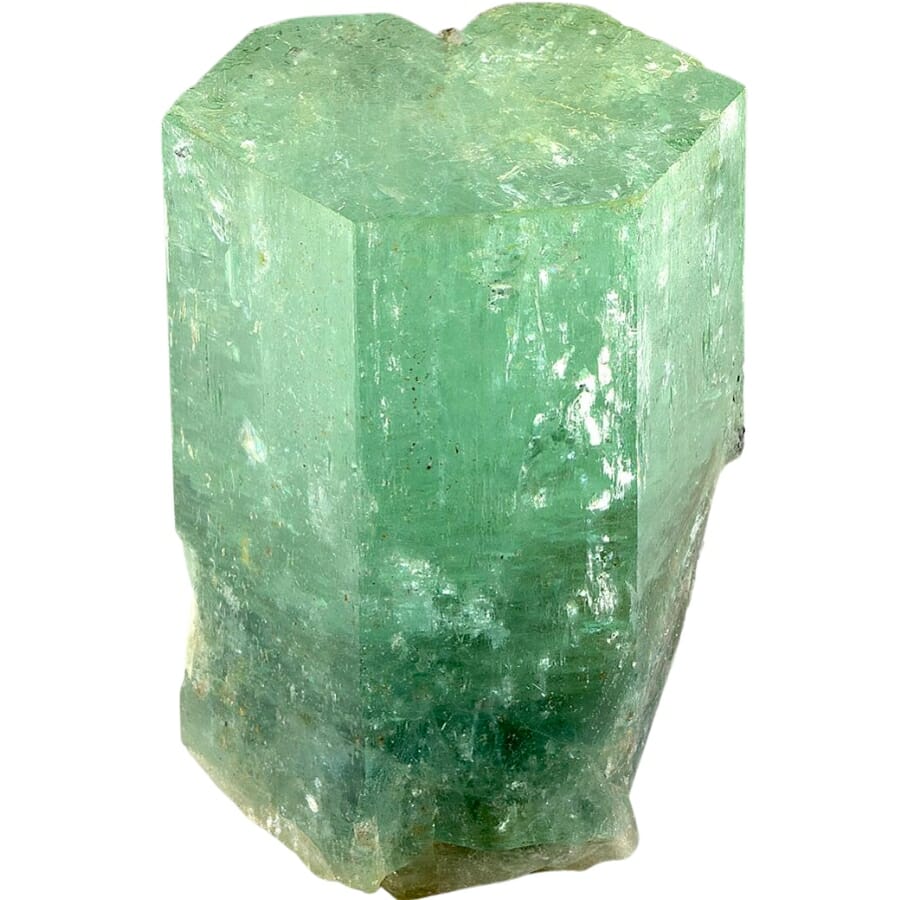
Pleochroism is a cool property that some gemstones, like aquamarine, have. It means that when you look at the gem from different angles, you might see different colors or shades of color.
Think of it like a magic trick where the gem changes color depending on how you look at it! For aquamarine, this color change is usually subtle. You might see different shades of blue or even a slight hint of green.
When checking for pleochroism, you can use a special tool called a dichroscope, or even just carefully rotate the gem and observe any color shifts.
Fake gemstones often don’t show this unique color-changing effect. If an “aquamarine” doesn’t display any pleochroism, it could be a sign it’s not genuine.
Try a refraction test
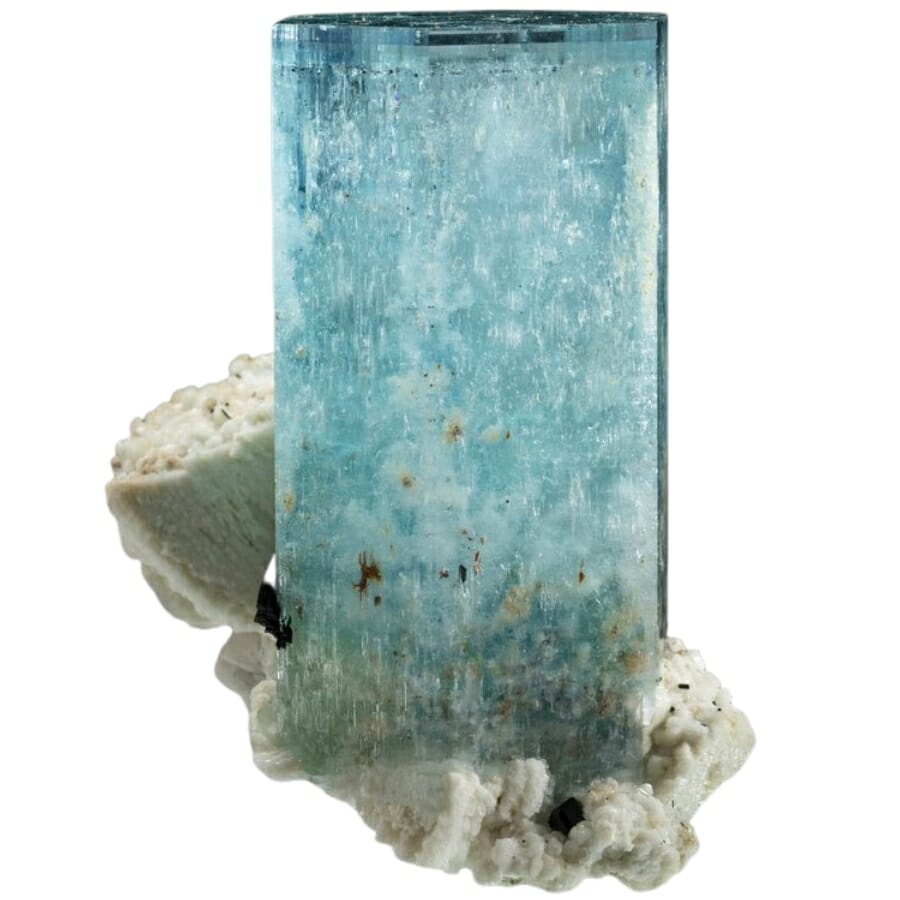
Every gemstone bends light in its own special way, and this bending of light is called refraction. Aquamarine has its own specific way of bending light, which is different from other gems or fake stones.
When you do a refraction test, you’re checking how much the light bends as it passes through the gemstone. This bending can make objects viewed through the gemstone look distorted or out of place.
For aquamarine, if the light bends in a way that matches its known refractive index, it’s a good sign the gem is real. If the light doesn’t bend the right way, the stone might be a fake or a different gem.
Observe for tiny inclusions or imperfections
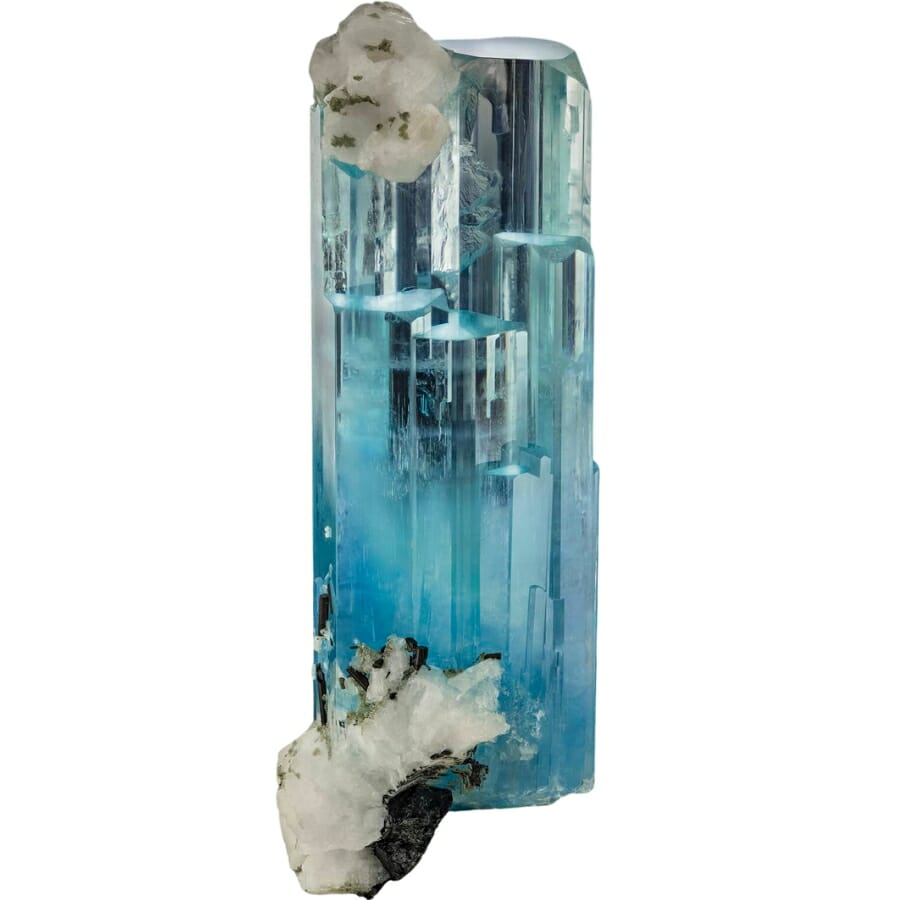
When we talk about gemstones, you might think that being perfectly clear is the best.
But tiny imperfections or inclusions inside an aquamarine can actually be a good sign! These inclusions are like birthmarks for the gemstone, showing that it grew naturally in the earth over a long time.
Most real aquamarines will have some of these tiny marks or flaws when you look closely, especially under a magnifying glass. On the other hand, fake stones or glass pieces will often be perfectly clear or might have bubbles.
So, if you’re checking an aquamarine and you see small inclusions inside, don’t be quick to think it’s a bad thing. These little birthmarks might be telling you that your gemstone is the real deal.
Do a simple scratch test
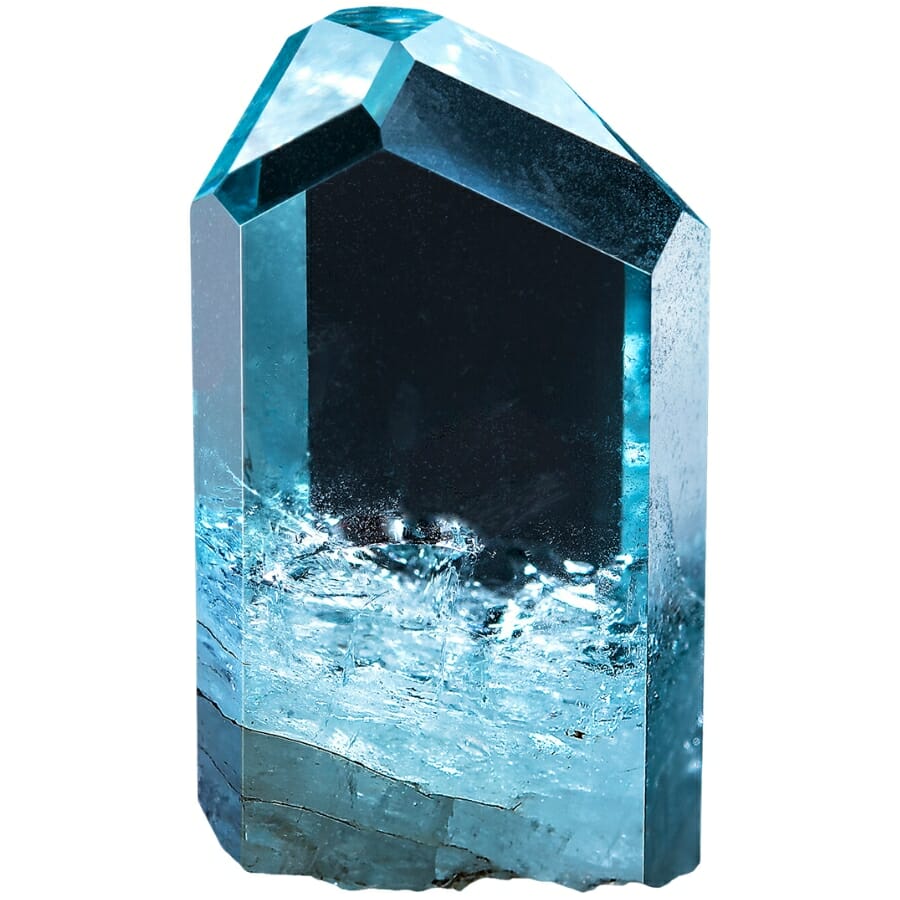
On the Mohs scale of hardness, aquamarine scores pretty high, between 7.5 to 8. This means it’s a tough gemstone and isn’t easily scratched.
The scratch test is a simple method where you try to scratch the gemstone with something of a known hardness, like a coin or a knife blade.
Since aquamarine is hard, a coin or knife blade shouldn’t be able to leave a mark on it. But if you find that the “aquamarine” gets scratched easily, it could be a sign that it’s not the real thing and might be made of a softer material or glass.
This test is helpful because it’s quick and doesn’t need any fancy tools. But always be gentle! You don’t want to damage a genuine gem by pressing too hard.
The Different Types Of Fake Aquamarine And What They Look Like
In this section, we’ll share with you the different natural and man-made rocks being peddled as fake aquamarines. By getting to know this gem’s look-alikes, you’ll be able to watch out for them and avoid buying them for the price of a real aquamarine.
Blue Glass
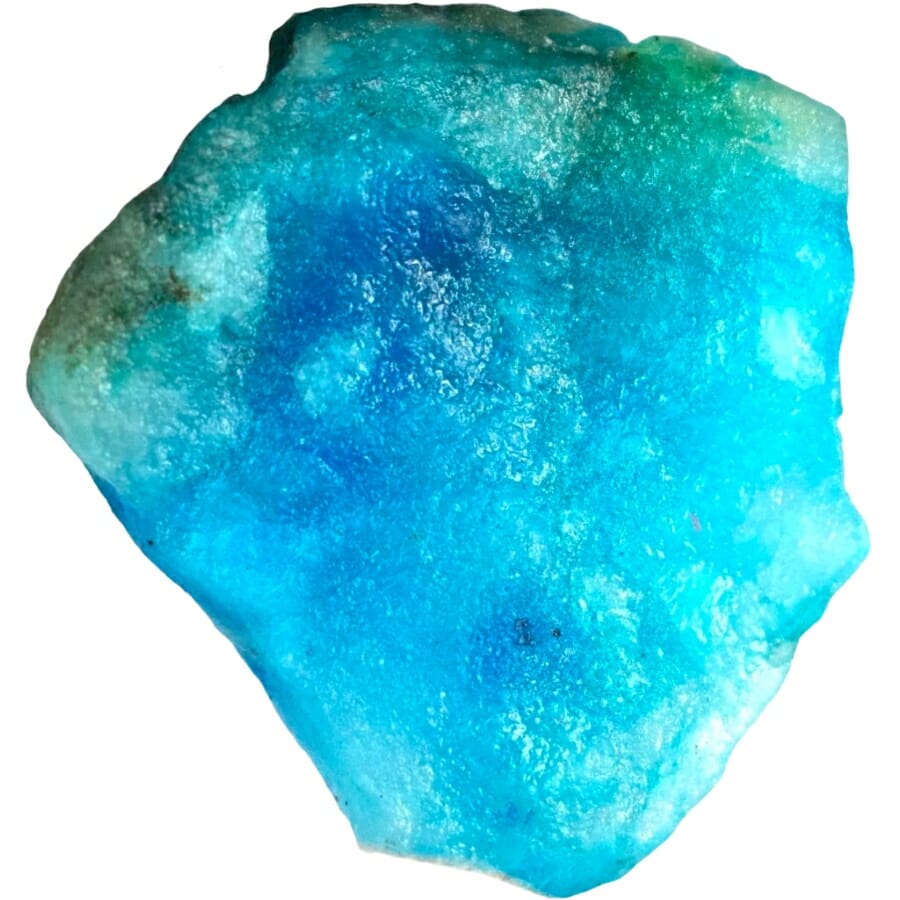
Blue glass is made by melting together several ingredients, mainly sand (which is mostly silica), soda ash, and limestone.
To get that lovely blue color, small amounts of certain metals or minerals are added. For example, adding cobalt oxide can give a deep blue color, while adding copper can produce a lighter blue shade.
Once everything’s mixed and melted, the mixture is cooled and shaped into desired forms. To make it look like aquamarine, it’s usually cut and polished just like real gemstones. This helps give it that shiny, sparkling look that real gemstones have.
Because blue glass is much cheaper to produce than mining genuine aquamarine, some people try to sell it as the real thing to make more money. When shaped and polished, blue glass can sometimes look quite convincing, especially to someone who’s not used to examining gemstones closely.
However, there are differences, and while blue glass can be beautiful in its own right, it doesn’t have the same value or properties as genuine aquamarine.
How you can identify blue glass being sold as real aquamarine
Check for bubbles
Blue glass might have tiny air bubbles trapped inside. Real aquamarine won’t have these. Using a magnifying glass, you can look closely at the stone, and if you see little bubbles, it might be glass.
Test its hardness
Glass is softer than aquamarine. Gently try to scratch the surface with a steel pin or the tip of scissors. If it leaves a mark, it’s probably glass. Be careful not to press too hard or damage a genuine gem!
Examine its color
Glass might have uneven color, while real aquamarine usually has a consistent shade of blue or greenish-blue. If you see spots with different shades of blue or areas that look painted on, be suspicious.
Blue Topaz
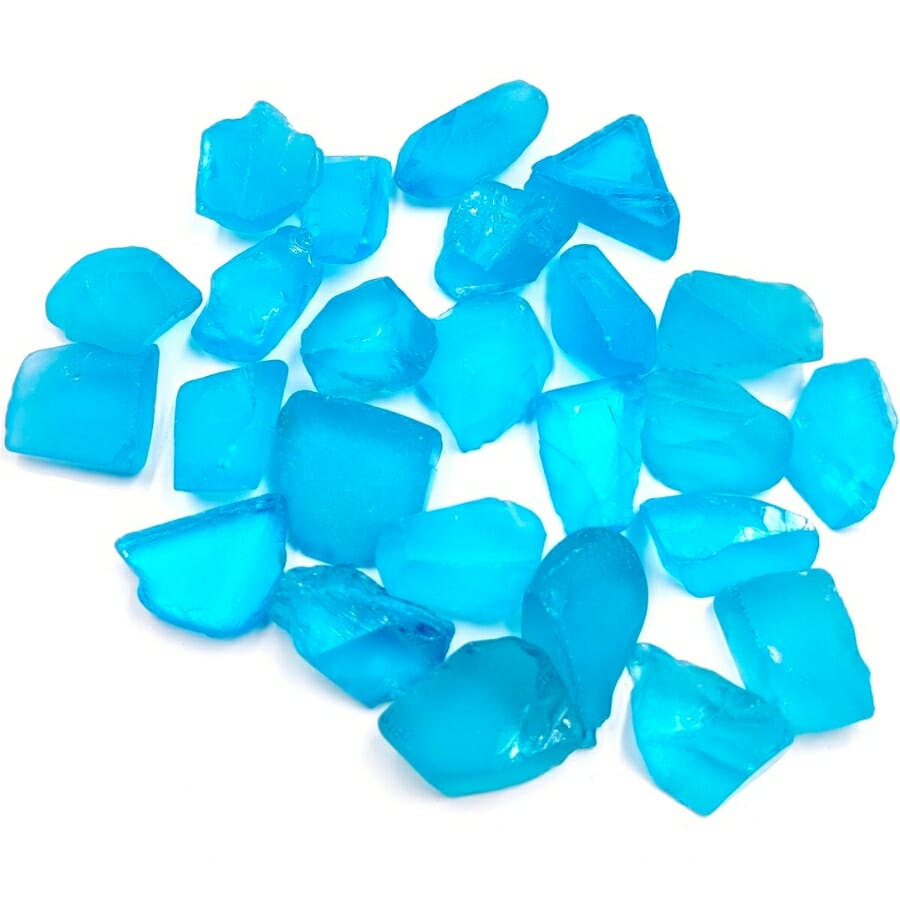
Blue topaz starts its life mostly colorless or with a light hue. It’s a naturally occurring gemstone, found in igneous rocks.
Here’s where the blue comes in. While some topaz are naturally blue, it’s rare. Most of the bright blue topaz you see in stores gets its color from a little help. This means it’s treated with radiation and then heated, which gives it that lovely blue color.
Because blue topaz is more common and generally less expensive than aquamarine, some people might try to sell it as aquamarine to get a higher price. They look somewhat similar, with both being transparent and having a sparkling blue color.
However, there are many differences between aquamarine and blue topaz. Being aware of them and asking the right questions can make sure you’re not fooled.
How you can identify blue topaz being sold as real aquamarine
Look at the color
Blue topaz usually comes in a wider range of blues than aquamarine. While aquamarine is often a pale blue or greenish-blue, blue topaz can be very light to very dark. If you see a stone that’s a deep, rich blue, be cautious; it might be blue topaz.
Check the price
Aquamarine is generally more expensive than blue topaz. If you find a “bargain” that seems too good to be true, it could be because you’re actually looking at blue topaz.
Inspect for flaws
Aquamarine often has some tiny inclusions or imperfections. Blue topaz, especially the treated ones, can be super clear without many, if any, internal flaws. If a stone is perfectly clear and deep blue, it might lean more towards being a blue topaz.
Spinel
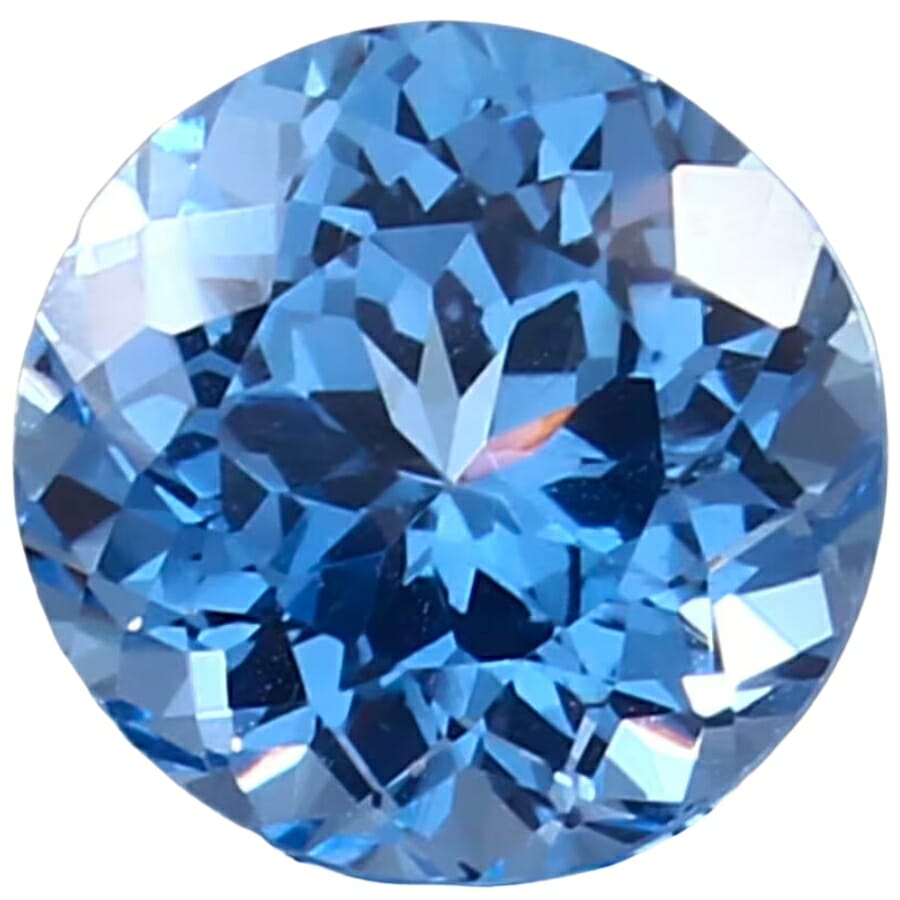
Spinel is created when limestone is exposed to high temperatures and pressures. It’s often found in marble or certain types of rocks called pegmatites. Spinel can come in many colors, from reds and pinks to blues and purples.
Now, when we think of spinel, blue isn’t the first color that comes to mind. Red spinel, for instance, has historically been mistaken for ruby. However, blue spinel does exist, and its cool, blue shade can sometimes look a lot like aquamarine.
Because genuine aquamarine can be pricier and is quite popular, some sellers pass off a less expensive blue spinel as aquamarine to make more money. They count on buyers not knowing the difference.
The colors might be similar, but the two stones have different properties and structures. If you’re keen on getting a real aquamarine, it’s essential to know that blue spinel exists and how to tell them apart.
How you can identify spinel being sold as real aquamarine
Feel the weight
Spinel and aquamarine have different densities. If you’ve handled a lot of gemstones, you might notice that spinel feels a bit heavier than aquamarine of the same size.
Examine the brilliance
While both stones are sparkly, spinel generally has a higher brilliance than aquamarine. If the stone seems exceptionally sparkly and bright, you might be looking at a spinel.
Check for double refraction
Using a magnifying glass, take a close look at any inclusions or lines inside the stone. Aquamarine will show a doubling effect of these internal features because of its double refraction, whereas spinel will not.
Quartz

Quartz is one of the most common minerals. It forms when magma cools and hardens. Over time, silicon and oxygen atoms bond together to make clear, beautiful crystals.
Quartz can come in many colors, based on tiny amounts of other minerals that get trapped inside. One type of it is blue quartz, which has a color somewhat similar to aquamarine. It gets its color from inclusions of other minerals, or sometimes from tiny bits of radiation from nearby rocks.
Because aquamarine is a cherished and sometimes costly gemstone, some people try to pass off blue quartz as aquamarine. The two can look similar, especially to someone who isn’t a gem expert.
Blue quartz is often more readily available and cheaper than aquamarine, which makes it tempting for some sellers to misrepresent it.
How you can identify quartz being sold as real aquamarine
Check the clarity
Aquamarine usually has fewer inclusions or tiny imperfections than blue quartz. If you’re looking at a stone that seems to have many little marks or cloudy areas inside, it might be quartz.
Feel the surface
Quartz is a bit harder than aquamarine. If the gem feels very scratch-resistant, more than you’d expect from an aquamarine, it could be a hint you’re handling quartz.
Examine the color
Blue quartz tends to have a more uneven color, with patches of light and dark. Aquamarine usually has a more consistent, even blue or greenish-blue shade throughout the stone.
Turquoise
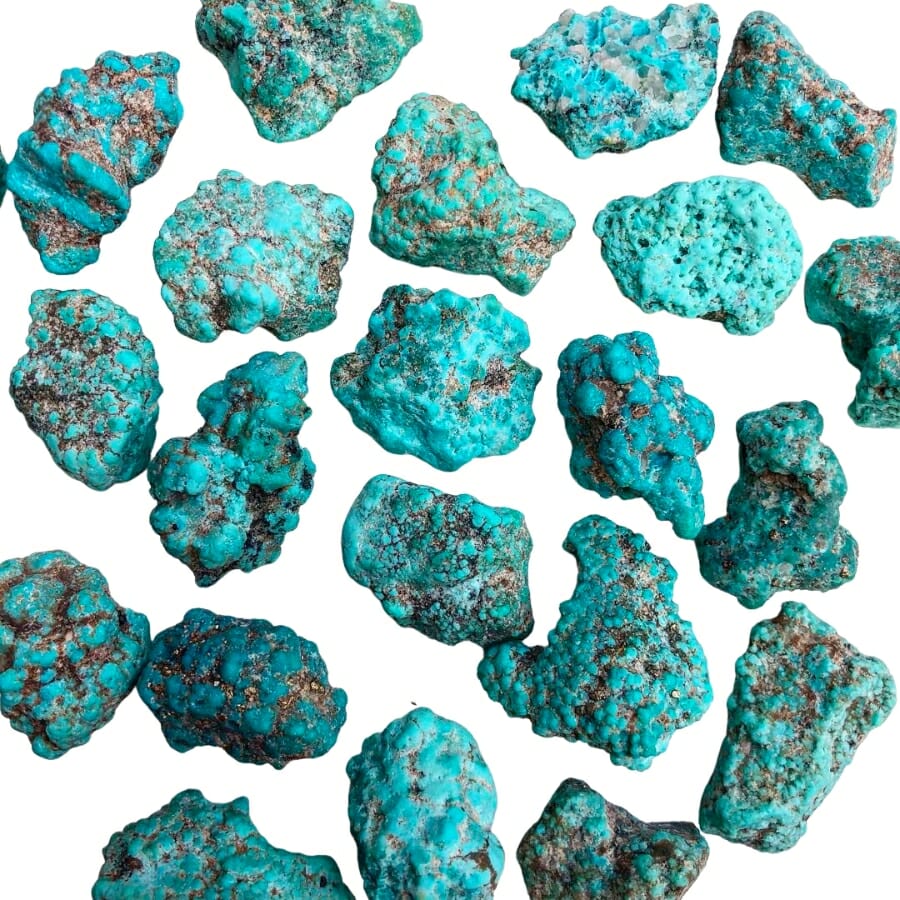
Turquoise forms in a different way than aquamarine. When water seeps through rocks, it can carry certain minerals with it. Over time, these minerals build up in cracks or spaces in the rock.
As they collect and react with each other, they can form turquoise. This usually happens in dry, arid places where copper-rich minerals are present. The copper gives turquoise its famous blue or greenish-blue color.
If you compare aquamarine vs turquoise, you’ll notice that these two stones can look a bit alike. Both can have a blue or greenish-blue color. But there’s a catch: the deep, rich color and unique patterns of turquoise make it stand out.
Yet, some sellers, hoping to profit from the high value and demand of aquamarine, might try to pass off turquoise as aquamarine. They could do this by cutting and polishing turquoise in ways that make it look more like aquamarine. Or, they might treat or dye the turquoise to change its color.
How you can identify turquoise being sold as real aquamarine
Look at the patterns
Turquoise often has unique patterns or markings called “matrix.” These are web-like lines or patches, usually in brown or black. Aquamarine, on the other hand, is generally clear without such patterns.
Examine the color depth
Turquoise comes in a range of blues to greenish-blues, often with a more vibrant and opaque appearance. Aquamarine usually has a more translucent quality with a lighter, consistent blue or greenish-blue shade.
Feel the weight
Turquoise is a lighter-weight gem compared to aquamarine. If a gem feels unexpectedly light for its size, it could be a clue that it’s turquoise.
How To Tell If Aquamarine Is Real Vs Fake
There are many ways buyers are fooled into buying fake aquamarine because they don’t know the telltale signs of an imitation. You shouldn’t be one of them!
We’ll teach you different tips and tricks on identifying fake aquamarine, whether it’s cut and polished or raw.
How to identify fake aquamarine when it’s cut or polished
Distinguishing genuine aquamarine can be a challenge, especially when the gemstone is cut or polished. Despite this, there are subtle differences you can watch out for to successfully tell between a fake and real aquamarine.
Uneven color or unnatural bright shades of blue

One of the most telling signs that an aquamarine might be counterfeit is its color distribution and shade. Real aquamarine has a gentle, consistent blue to greenish-blue hue. This hue is often soft and subtle, not overly bright or flashy.
When you look at a genuine aquamarine, its color will generally be evenly spread throughout the gem, with no drastic changes or patches.
On the other hand, fake aquamarines, especially those made of glass or dyed other minerals, can show uneven color. Some parts of the gem might be darker or lighter than others. This is because it’s challenging to dye or manufacture a stone with a consistent color all over.
Additionally, some counterfeit aquamarines are unnaturally bright blue. This super bright shade can be enticing, but it’s usually a dead giveaway.
No inclusions or with tiny bubbles

Aquamarine often has tiny inclusions, which are natural signs of the gem’s formation in the earth. They can be tiny cracks, minerals, or even other crystals that got trapped inside the aquamarine as it was growing.
When an aquamarine is super clear with absolutely no inclusions, it might sound like a good thing, right? Well, not always. Perfect clarity can actually be a sign that the gem isn’t genuine.
Nature rarely makes things perfect, and a gem with no inclusions at all might be too good to be true. It could be a sign that the gem was made by people in a lab or that it’s another type of stone entirely.
Another thing to look out for is tiny bubbles. Bubbles are not typical for natural aquamarine. If you see them, it’s a big clue that you might be looking at glass, not a gemstone.
Easily scratched
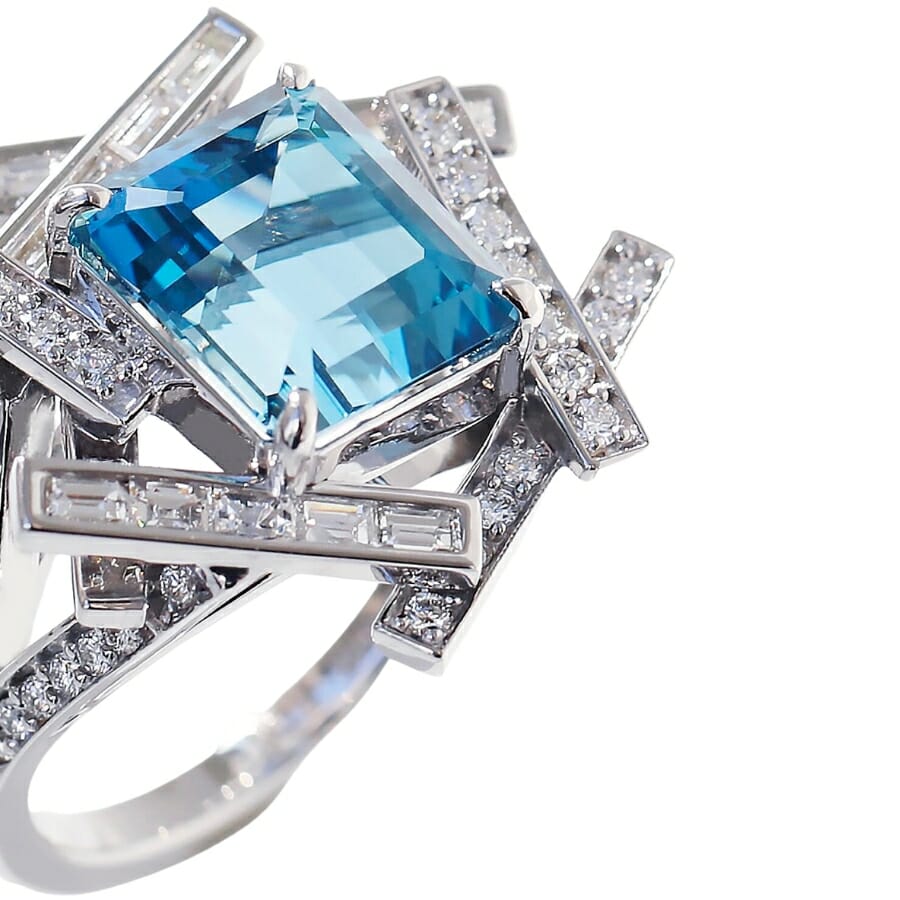
Aquamarine is a pretty strong gemstone, but how strong? In the Mohs scale, which ranks minerals from 1 to 10 based on how hard they are, it scores a 7.5 to 8, which means it’s pretty tough and not easily scratched.
Imagine you have a stone that’s supposed to be an aquamarine. If you notice that it gets scratched up easily, there’s a good chance it might not be real.
Real aquamarine should be able to resist scratches from materials that rank lower on the Mohs scale. For example, a copper coin shouldn’t leave a mark on genuine aquamarine. But if your stone gets scratched by it, you might be holding a fake.
When checking for scratches, use a magnifying glass or jeweler’s loupe. This way, you can get a closer look and be sure of what you’re seeing.
How to identify fake aquamarine when it’s raw
You might think distinguishing genuine aquamarine from imitations when in its raw form is a lot more easier, but it can be quite tricky, too. Below are some key indicators to help you identify genuine raw aquamarine from its crafty counterfeits.
Absence of pleochroism
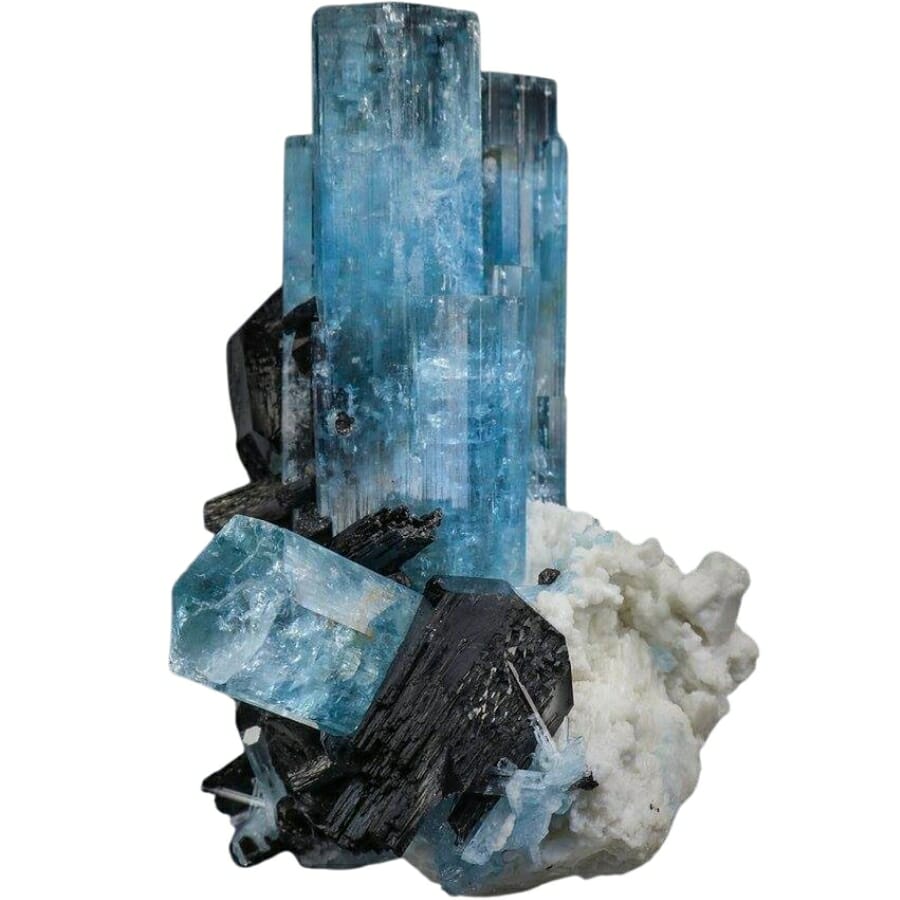
Pleochroism means a gemstone can show different colors when looked at from different angles. Think of it like a chameleon that changes colors depending on where you stand. Aquamarine has this unique property.
When you turn a raw aquamarine in different directions, you might see slight changes in its blue or green shade. If you’re holding what you think is a piece of raw aquamarine, look at it from various angles or rotate it under a light.
If the color stays exactly the same, it might not be the real deal. Fake or imitated gems often miss out on this neat color-changing trick. So, the absence of pleochroism can be a big hint that you’re dealing with a fake.
Unnatural smoothness or glossiness
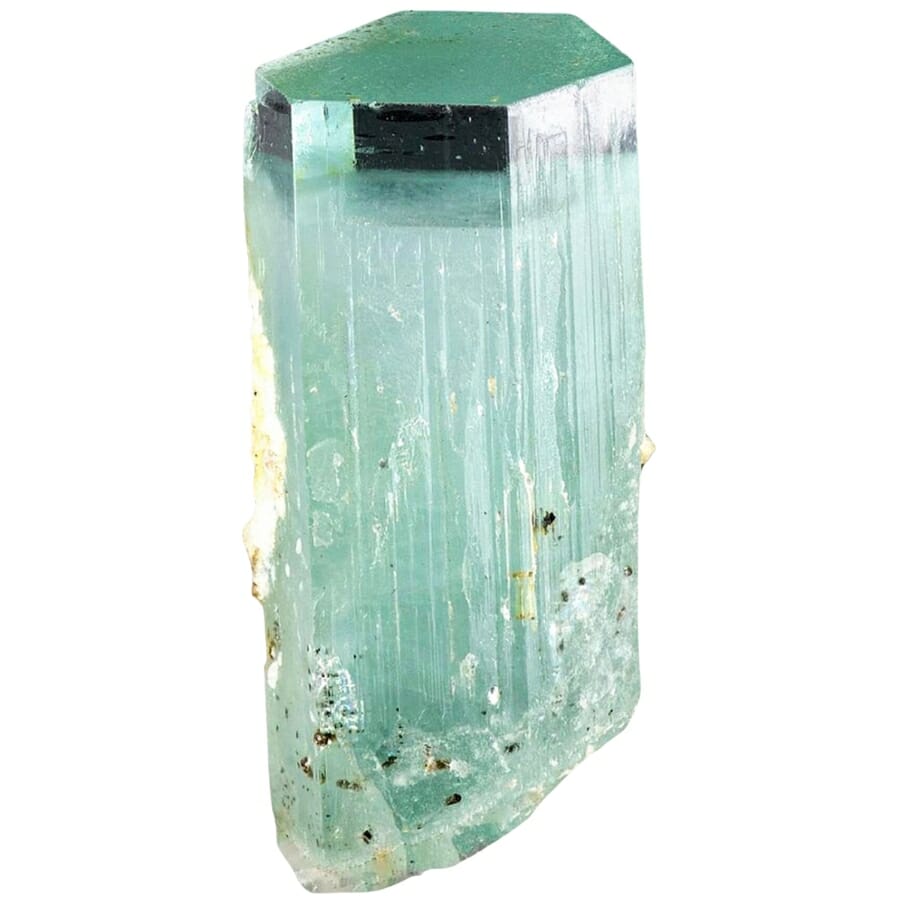
When you find a piece of raw aquamarine, it won’t be perfectly smooth or glossy like a glass marble. Instead, it will have rough, uneven surfaces and might even have tiny fractures or dents.
Someone trying to fool people by selling fake aquamarine might use materials that are too perfect, too smooth, or overly glossy to imitate the real thing. This unnatural smoothness can be a big giveaway!
If you’re holding a piece of what’s supposed to be raw aquamarine and it feels super smooth or has a shiny, glossy look, be careful. Nature rarely makes things perfect, and genuine raw aquamarine will have its natural imperfections.
So, if you’re trying to spot a fake, feel the texture. Real aquamarine should have a certain rugged charm, while fakes might feel too polished or too perfect.
Warm temperature
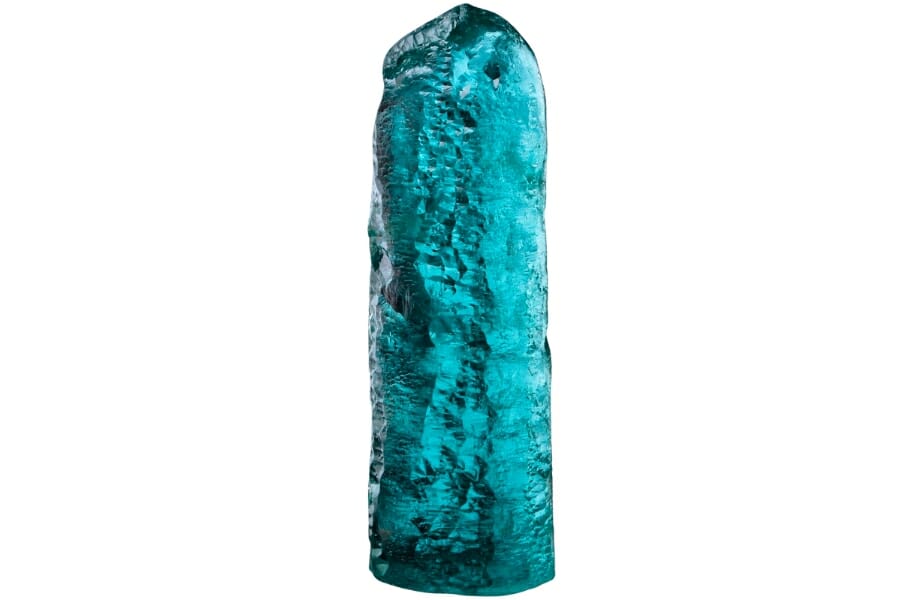
One interesting method to check if a raw aquamarine is real involves using temperature.
Genuine aquamarine stays cooler to the touch than imitations made from plastic or glass. When you pick up a real piece, it should feel cool against your skin, even if it was in a warm room.
Here’s why: Aquamarine has the ability to conduct heat away from your skin quickly. This makes the stone feel cold when you touch it. On the other hand, fake aquamarines, especially those made of plastic and many types of glass, retain heat, so they’ll feel warmer when touched.
If you’re examining a piece of raw, uncut aquamarine, try placing it against your cheek or the back of your hand. If it’s real, it should feel cool pretty quickly. If it feels warm or matches your skin’s temperature too fast, it might be fake aquamarine.

